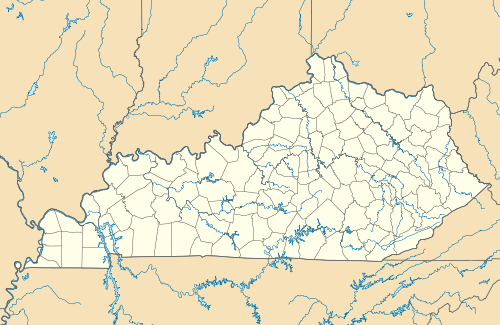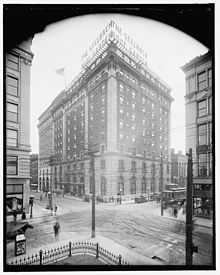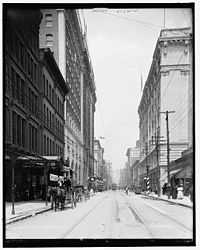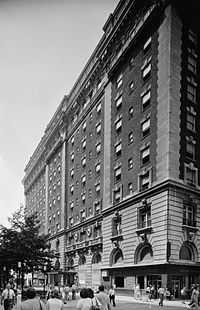Seelbach Hotel
| Seelbach Hotel | |
|---|---|
|
The Seelbach Hilton Hotel on 4th Street and Muhammad Ali Boulevard. | |
| General information | |
| Address | 500 South 4th Street, Louisville, Kentucky, United States, 40202 |
| Opening | May 1, 1905 |
| Owner | Hilton Hotels & Resorts |
| Website | |
| www.seelbachhilton.com | |
|
Seelbach Hotel | |
 | |
| Location | 500 S. 4th St., Louisville, Kentucky |
| Coordinates | 38°15′3″N 85°45′29″W / 38.25083°N 85.75806°WCoordinates: 38°15′3″N 85°45′29″W / 38.25083°N 85.75806°W |
| Area | 2 acres (0.81 ha) |
| Built | 1905 |
| Architectural style | Other, Beaux Arts Baroque |
| Governing body | Private |
| NRHP Reference # | 75000775[1] |
| Added to NRHP | August 12, 1975 |
The Seelbach Hilton is a historic hotel in Louisville, Kentucky, founded by Bavarian-born immigrant brothers Louis and Otto Seelbach. It opened in 1905 as the Seelbach Hotel, envisioned by the Seelbach Brothers to embody the old-world grandeur of European hotels in cities such as Vienna and Paris. To do so in early 20th century Louisville, they employed a French Renaissance design in constructing the hotel.[2] Louis was already a restaurant owner in Louisville when his brother Otto joined him from Germany around 1890, forming the Seelbach Hotel Co.[3] The Company began construction on the hotel in 1903.
The hotel was quickly regarded among the finest hotels in the United States and throughout its long history has been frequented by many notable Americans — for instance F. Scott Fitzgerald, who took inspiration from the Seelbach for a hotel in The Great Gatsby. The hotel is part of the Hilton Hotels & Resorts chain.
History
Louis Seelbach and his brother Otto emigrated from Frankenthal, Germany, a small, rural town in Bavaria. Louis Seelbach arrived in Louisville in 1869 at age 17, shortly after reaching the United States. He worked in the first Galt House for a time upon his arrival, but after turning 22 in 1874, he realized that he had greater ambitions. He opened the Seelbach Bar & Grill that same year, and quickly built it into a flourishing enterprise. The success of the restaurant in Louisville's quickly expanding population and economy allowed Louis Seelbach to bring his brother Otto from Germany to help open the first Seelbach Hotel in 1891 above the bar & grill on 6th and Main.[4]

The brothers were intent on building Louisville's first grand hotel: a hotel reflecting the opulence of European hotels. They purchased a piece of property at the corner of 4th and Walnut (now Muhammad Ali Blvd) Streets, broke ground in December 1903, and opened the doors on May 1, 1905, just in time for the Kentucky Derby.[5]
On the opening day, over 25,000 people visited the hotel. The Seelbach hosted a gala that evening, with dinner parties in each of the 150 rooms.[6] The structure incorporated marble from Italy, Germany and France, along with wood from the West Indies and Europe.[7]
The hotel attracted large numbers of patrons in its first two years, and, luckily, the Seelbach Realty Company – formed in 1902 before the property purchase – had been planning from opening day to expand the hotel. On January 1, 1907, the second phase opened, raising the number of rooms to 500. The lower two floors of the ten-story structure were faced with stone, while the upper floors were brick. Work included enclosing the rooftop garden to allow it to be used as a winter garden.[8] This new and improved Seelbach regularly hosted guests of the Kentucky Derby.
In 1925, Louis, president of the Seelbach Hotel Co., died, creating a need for new management. On April 1, 1926, Chicago-based businessman Abraham M. Liebling bought the hotel for approximately $2,500,000.[9]
In 1929, he sold the hotel to the Eppley Hotel Company for $2,000,000.[10] Mr. Eppley, of Omaha, Nebraska, owned many hotels throughout the Midwest, but eventually sold The Seelbach Hotel and all his other properties in 1956 to the Sheraton Hotel Corporation (now Sheraton Hotels and Resorts) as part of a $30,000,000 deal. This made the Seelbach part of the second largest hotel sale in all of US history.[11] The hotel became the Sheraton-Seelbach Hotel and later the Sheraton Hotel.

Sheraton sold the property in the mid 1970s and it regained the Seelbach name. Following a severe national economic slump in 1975, it was forced to close its doors after the owners went bankrupt. For a few years, it lay dormant. In 1978, Louisville native and Hollywood television actor, Roger Davis, intervened and restored the Seelbach. The work began in early 1979 and continued until the grand re-opening on April 12, 1982.[12] National Hotels Corporation, a subsidiary of Radisson Hotels and DoubleTree Hotels managed of the property which had regained much of its former reputation.[13]
The hotel has changed hands a number of times after its re-awakening. When MeriStar Hospitality Corp bought the hotel in 1998 and it became The Seelbach Hilton.[14] The Seelbach is jointtly owned by Interstate Hotels & Resorts and Investcorp and operates under the Hilton flag. In 2009, the hotel finished its most recent renovation at a cost of $12 million.[15]
Impact on Louisville
At the time of construction, little else existed in the area around 4th and Walnut Streets. When the Seelbach brothers proposed their project, the Mayor of Louisville said, "No one will come to a hotel so far away." Several others attempted to discourage building on property so far from the 'center' of Louisville.[6] Since then, Louisville has expanded and the Seelbach Hotel has long been astride one of the city's booming shopping and business districts. Between the 1930s and 1960s, the Seelbach Hotel even anchored an area with Louisville's "best shops".[16] Although it fell into disrepair for a period, today the area is again a bustling cultural and commercial center.
Notable guests

- Presidents
Many US Presidents have chosen to spend time at the hotel while in Louisville, including William Howard Taft (1911), Woodrow Wilson (1916), Franklin D. Roosevelt (1938), Harry Truman (1948), John F. Kennedy (1962), Lyndon B. Johnson (1964), Jimmy Carter (1970s), Bill Clinton (1998), and George W. Bush (2002).[17]
- Gangsters
Lucky Luciano, Dutch Schultz, and Al Capone – who was a frequent guest of the Seelbach – stayed at the hotel, often for clandestine poker games. One story from the 1920s involves Al Capone sneaking out through a series of secret stairways and tunnels when Louisville Police broke up one of these games.[18] Hotel staff are frequently eager to show the Al Capone room (if it is unoccupied) and give its history.
- Others
The Rolling Stones, Whitney Houston, Elvis Presley, Billy Joel, Robin Williams, Russel Crowe, Julia Child, and Wolfgang Puck are among those celebrities who have stayed at the Seelbach.[19]
F. Scott Fitzgerald frequented the hotel in April 1918, while training for his deployment in World War I. One night after expensive bourbon and cigars however, he had to be restrained and ejected of the hotel.[20] This experience seemingly did not tarnish his memories however, as he later included a fictional hotel akin to the Seelbach as the setting for the wedding of Tom and Daisy Buchanan in The Great Gatsby.[21]
Hotel

The Seelbach is a AAA 4 Diamond award-winning hotel.[22] The hotel appears on the National Register of Historic Places and is considered "Louisville's Historic Hotel".[23]
Amenities
The Seelbach offers its guests in Louisville access to its AAA Five Diamond award winning restaurant The Oakroom, fitness center, and valet parking, among other standard features of a luxury hotel.[24]
Restaurants
Restaurants in the Seelbach include the The Oakroom, Gatsby's on Fourth, and Starbucks. The Oakroom is Kentucky's only AAA Five Diamond Restaurant Award winner, one of 44 in the nation[25] while the Rathskellar, decorated with Rookwood Pottery, was a rare and distinctively Seelbach south-German influenced restaurant.[23] Today the Rathskeller is used for occasional private events. Coming from German, the term "Rathskeller", means "council's cellar" and is a common name in German-speaking countries that refers to a bar or restaurant located in the basement of a city hall (Rathaus). The word "Rath" has nothing to do with the German word "Ratten" (rats) as has been mistakenly reported in some instances.
In film
The Seelbach Hotel was featured in the 1999 Russell Crowe/Al Pacino film "The Insider".
See also
Notes
- ↑ "National Register Information System". National Register of Historic Places. National Park Service. 2010-07-09.
- ↑ Johnson, The Seelbach, 18.
- ↑ Johnson,The Seelbach, 14–16.
- ↑ Johnson, The Seelbach, 14.
- ↑ Johnson,The Seelbach, 16–18
- ↑ 6.0 6.1 Johnson, The Seelbach, 17.
- ↑ Johnson, The Seelbach, 20.
- ↑ Johnson, The Seelbach, 34.
- ↑ Johnson, The Seelbach, 39–40.
- ↑ Johnson, The Seelbach, 50.
- ↑ "Closing the gap". Time. June 4, 1956. Retrieved June 22, 2014.
- ↑ Johnson, The Seelbach, 56–68.
- ↑ The Seelbach: A Centennial Salute to Louisville's Grand Hotel (PDF). p. 21.
- ↑ Karman III, John R. (June 11, 2001). "Seelbach Hotel owner bought by Texas REIT". Louisville Business First. Retrieved June 22, 2014.
- ↑ "Renovations at The Seelbach Complete" (PDF) (Press release). The Seelbach Hilton. March 12, 2009. Retrieved June 22, 2014.
- ↑ Johnson, The Seelbach, 81.
- ↑ Johnson, The Seelbach, 85, 88, 94.
- ↑ Johnson, The Seelbach, 82–83.
- ↑ Johnson, The Seelbach, 92.
- ↑ Johnson, The Seelbach, 36.
- ↑ Johnson, The Seelbach, 37.
- ↑ "4 Diamond Award Winning Lodging", AAA
- ↑ 23.0 23.1 "Louisville's Historic Hotel". Hilton Hotels and Resorts.
- ↑ "Services and Amenities". Hilton Hotels and Resorts.
- ↑ "Five Diamond Restaurants" (PDF). AAA. January 17, 2014. Retrieved June 22, 2014.
References
- Domine, David. Insiders' Guide to Louisville. Guilford, CT: Globe-Pequot Press, 2010. ISBN 978-0-7627-5695-7.
- Johnson, Larry. The Seelbach: A Centennial Salute to Louisville's Grand Hotel. Louisville: Butler Books, 2005. ISBN 1-884532-65-9.
External links
| ||||||||||
| ||||||||||||||||||||||||||
